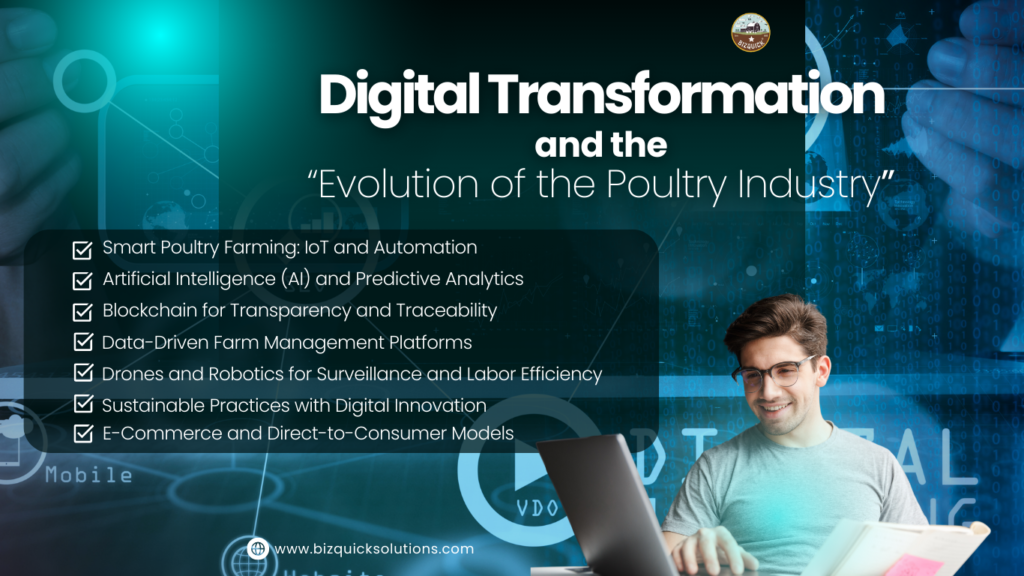- Bizquick Estates & Overseas Pvt Ltd
- +1-725-207-3489
- +91-774-508-5581

The poultry industry, like many other sectors, is undergoing a significant transformation driven by advancements in digital technology. As the global demand for poultry products continues to grow, the need for efficiency, sustainability, and innovation in production processes has never been more crucial. Digital transformation is helping poultry farmers, producers, and suppliers embrace new technologies that optimize operations, reduce costs, and improve overall productivity. This shift is revolutionizing the traditional poultry industry, mixing new-age technology with age-old farming practices to create a more resilient and forward-looking sector.
Below are some key areas where digital transformation is impacting and mixing with the poultry industry.
The use of Internet of Things (IoT) devices and automation is at the forefront of digital transformation in poultry farming. IoT-enabled sensors and systems allow farmers to monitor the environment of poultry houses in real-time, including temperature, humidity, feed, and water levels. These devices help automate processes such as feeding, ventilation, and lighting, reducing human intervention and ensuring optimal conditions for the poultry at all times.
For example, automated feeders and drinkers can ensure that poultry receives adequate nutrition without wastage, while smart ventilation systems adjust airflow based on temperature or humidity changes. This automation helps improve animal welfare, enhance farm efficiency, and boost production yields.
Artificial Intelligence (AI) is rapidly changing how poultry farms operate by enabling predictive analytics and decision-making. AI-driven data analytics can help farmers predict disease outbreaks, forecast growth rates, and optimize feeding schedules based on the health and behavior of the flock.
By analyzing data collected from various sensors, AI systems can detect subtle changes in poultry behavior, which could be early signs of illness or stress. This allows farmers to intervene promptly, preventing widespread outbreaks and reducing mortality rates. AI also helps with precision feeding by determining the ideal nutritional mix based on real-time data, thereby minimizing feed waste and improving the overall health of the flock.
As consumers become more conscious of food safety and ethical sourcing, blockchain technology is playing a crucial role in enhancing transparency and traceability in the poultry supply chain. Blockchain allows for the secure, decentralized recording of every step in the production and distribution process—from the hatchery to the retail store.
Through blockchain, consumers can trace the origin of the poultry products they purchase, ensuring they meet quality standards and were raised under ethical farming practices. For producers, blockchain can provide a reliable way to demonstrate compliance with food safety regulations, reduce fraud, and improve overall supply chain efficiency.
Digital farm management platforms are revolutionizing how poultry farms operate by providing centralized systems that manage and analyze various aspects of farm operations. These platforms integrate data from IoT devices, financial records, supply chain information, and even employee management into a single dashboard.
Farmers can use these platforms to track flock health, manage inventory, schedule tasks, and monitor expenses. Such data-driven insights allow for more informed decision-making, helping farmers optimize operations, reduce costs, and improve profitability. These platforms can also predict market trends, helping farmers adjust their production in anticipation of changes in demand or pricing.
The use of drones and robotics in poultry farming is another exciting frontier in digital transformation. Drones equipped with thermal imaging or cameras can be used to monitor large poultry farms from the air, allowing for quick assessments of flock health and farm conditions. This technology helps identify issues such as overcrowding, dead birds, or environmental hazards without the need for constant human inspection.
Meanwhile, robots are being used to handle repetitive tasks such as egg collection, waste removal, and cleaning, reducing the need for human labor and lowering operational costs. Robotics also help improve biosecurity by minimizing the movement of workers within poultry houses, thus reducing the risk of disease transmission.
Sustainability is becoming increasingly important in the poultry industry, and digital transformation is helping farmers implement more eco-friendly practices. Precision farming technologies can reduce water and feed wastage, while energy-efficient systems powered by renewable sources like solar panels help reduce carbon footprints.
Farmers are also adopting circular economy practices, such as converting poultry waste into organic fertilizer or using data analytics to minimize waste at every step of the supply chain. By incorporating these sustainable practices into their operations, farmers can reduce costs and meet the growing consumer demand for eco-conscious products.
Digital transformation is also changing how poultry products are sold and delivered to consumers. With the rise of e-commerce platforms, many poultry producers are adopting direct-to-consumer (D2C) models, cutting out middlemen and selling fresh products directly to customers online. This allows for fresher, more traceable products and creates opportunities for branding and customer loyalty.
E-commerce platforms also provide producers with a broader reach, enabling them to serve both local and international markets more efficiently. By leveraging digital marketing strategies, such as social media and targeted online ads, producers can attract new customers and increase sales.
Digital transformation is mixing with the poultry industry in profound ways, creating opportunities for increased efficiency, sustainability, and profitability. The integration of technologies like IoT, AI, blockchain, robotics, and data analytics is revolutionizing traditional farming practices and helping poultry farmers overcome the challenges of modern agriculture.
As technology continues to evolve, the poultry industry must embrace these changes to remain competitive and meet the growing global demand for high-quality, sustainable poultry products. Those who invest in digital tools and innovations will be better equipped to thrive in the dynamic, tech-driven future of agriculture.
Bizquick Estates & Overseas Pvt Ltd
Bizquick aims to be one of the leaders in managed business. Bizquick develops, produces, manages, harvests, processes and markets the products by covering the entire process.
Passive Income
Your path to passive income for lifetime starts with Bizquick